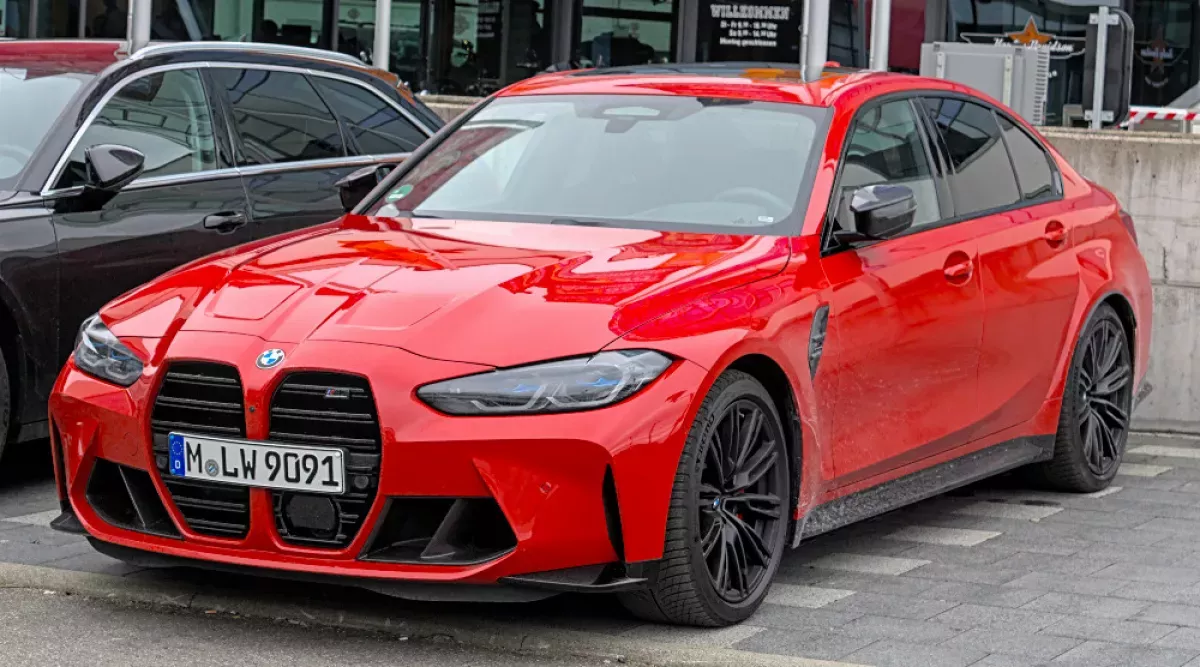1985: BMW M3 E30 Debut
The BMW M3 was first unveiled to the public at the 1985 Frankfurt Motor Show, generating significant excitement among car enthusiasts.
March 1986: Production Start of the BMW E30 M3
March 1986 marked the beginning of production for the highly anticipated E30 M3, initially launched as a homologation special.
1986: BMW M3 Pickup Prototype
BMW surprised enthusiasts by creating a one-off "M3 Pickup" prototype in 1986, based on the convertible model. This unique vehicle served as a transporter for BMW M for over two decades.
1986: BMW M3 E30 Introduction
The first BMW M3, a high-performance version of the BMW 3 Series, was introduced in 1986. Developed by BMW's motorsport division, BMW M GmbH, it was initially available as a coupé.
May 1987: BMW M3 Evolution 1 Release
BMW released the "Evolution" model, also known as "EVO1," in May 1987. This model featured a revised cylinder head for performance enhancement. BMW France also commissioned a special edition of the Evolution 1 to celebrate the M3's victory at the 1987 Tour de Corse.
1987: BMW M3's First Spa 24 Hours Victory
The BMW M3 demonstrated its endurance racing capabilities by securing its first victory at the Spa 24 Hours in 1987.
1987: BMW M3's Rally Debut and Tour de Corse Victory
The BMW M3 entered the world of rally racing in 1987. Despite facing tough competition, it secured a notable victory at the Tour de Corse with Bernard Béguin behind the wheel.
May 1988: BMW M3 Evolution 2 Release
To enhance the M3's competitiveness, BMW introduced the Evolution 2 in May 1988. This model boasted a revised camshaft, pistons, increased compression ratio, a more efficient air intake, a lightened flywheel, and distinctive visual cues like a BMW Motorsport tricolour camshaft and intake plenum cover.
1988: BMW M3 Racing Debut
The BMW M3 made its racing debut in 1988, showcasing its performance capabilities in various motorsport events.
April 1989: BMW M3 Ravaglia and Cecotto Edition Release
In April 1989, BMW released the special Ravaglia and Cecotto editions of the M3, named after renowned Deutsche Tourenwagen Meisterschaft (DTM) racing drivers. These editions featured increased power output and unique design elements.
1989: BMW M3 in Rallying
By 1989, the BMW M3 rally cars, prepared by Prodrive, had undergone significant upgrades, including a six-speed gearbox and a more powerful engine.
1989: BMW M3's First 24 Hours Nürburgring Victory
The BMW M3 achieved a significant milestone in 1989 by securing its first victory at the prestigious 24 Hours Nürburgring race.
1990: BMW M3 Sport Evolution Release
BMW unveiled the highly anticipated "Sport Evolution" model, also known as "EVO3," in 1990. This limited-production model featured a more powerful and lighter engine, aerodynamic enhancements, and upgraded brakes.
1990: BMW M3's Second 24 Hours Nürburgring Victory
Continuing its winning streak, the BMW M3 achieved its second consecutive victory at the 24 Hours Nürburgring in 1990.
1990: Introduction of the 2.5L Evolution Engine in Racing
In 1990, BMW introduced a more powerful 2.5-liter evolution engine for the M3 race cars. This engine upgrade significantly boosted the M3's performance in motorsport.
June 1991: End of E30 M3 Production
Production of the iconic E30 M3 concluded in June 1991, marking the end of an era for this legendary model.
1991: BMW M3's Third Consecutive 24 Hours Nürburgring Victory
The BMW M3 dominated the 24 Hours Nürburgring once again in 1991, securing its third consecutive victory in this challenging race.
November 1992: BMW M3 E36 Coupé Launch
BMW introduced the second generation of the M3, the E36, in November 1992. It was initially launched as a coupé, and the design marked a departure from the boxier E30.
1992: BMW M3's Fourth 24 Hours Nürburgring Victory and Spa 24 Hours Domination
1992 was a triumphant year for the BMW M3, as it not only achieved its fourth victory at the 24 Hours Nürburgring but also secured its fourth victory at the Spa 24 Hours.
January 1994: Canadian Edition BMW M3 Release
In January 1994, before the North American specification M3 was released, BMW Canada imported and sold 45 European-spec M3s. Despite the high price tag of nearly $60,000 CAD, all 45 cars were sold within 3 days, highlighting the demand for the M3 in Canada.
December 1994: BMW M3 E36 Saloon Launch
BMW launched the saloon (sedan) variant of the E36 M3 in December 1994 to bridge the gap between the E34 and E39 M5 models.
1994: BMW M3's Fifth 24 Hours Nürburgring Victory
Adding to its impressive track record, the BMW M3 claimed its fifth victory at the 24 Hours Nürburgring in 1994.
1994: BMW M3 E36 Convertible and Saloon Launch
In 1994, BMW expanded the M3 lineup by introducing a convertible version of the E36 generation. Later that year, a saloon version was also added to the lineup.
1994: BMW M3 GT Release
In 1994, BMW released the limited-edition M3 GT, a homologation special built for racing in Europe. The car was designed to meet the requirements of the FIA-GT class II, IMSA GT, and international long-distance races.
September 1995: BMW M3 E36 Facelift (Coupé)
BMW gave the E36 M3 Coupé a facelift in September 1995. Key changes included an engine displacement increase to 3.2 liters, an upgrade from a 5-speed to a 6-speed manual transmission, new wheel designs, and clear indicator lenses.
November 1995: BMW M3 E36 Facelift (Saloon)
Following the coupé's update, the saloon version of the E36 M3 also received the facelift changes in November 1995.
1995: Engine Upgrade for Facelifted E36 M3 Models
BMW introduced an upgraded 3.2-liter S50 engine for the facelifted E36 M3 models in late 1995. However, North American models used the less powerful S52 engine due to emission regulations.
1995: BMW M3 Lightweight Release
In 1995, due to pressure from US racing teams, BMW introduced a homologation version of the E36 M3 called the 'M3 Lightweight'. Designed to be lighter and thus faster on the track, this stripped-down version lacked amenities like a radio, air conditioning, leather seats, a toolkit, and a sunroof. With aluminium door skins, thinner underbody insulation, and special carpeting, the M3 Lightweight was 91 kg lighter than the regular E36 M3.
1995: End of E34 M5 Production
The year 1995 marked the end of production for the E34 generation of the BMW M5. BMW wouldn't release the next-generation M5, the E39, until 1998.
February 1996: BMW M3 E36 Facelift (Convertible)
Completing the facelift rollout, the convertible version of the E36 M3 received the updates in February 1996.
1996: BMW M3 Compact Prototype
In 1996, BMW M developed a prototype for an E36 M3 Compact, aiming to attract a younger demographic with a smaller and potentially more affordable M car. Despite positive reviews, it never went into production.
1996: M3 Evolution Imola Individual Release
In 1996, BMW released a limited edition of the M3 called the M3 Evolution Imola Individual. With only 50 units produced for the UK, the car featured an exclusive "Imola Red" paint job and an interior with Nappa leather seats in Imola Red and Amaretta suede bolsters in anthracite. Although its engine remained unchanged from the 1996 European M3, it came equipped with features like side airbags, the M3 GT Class II rear spoiler, and more.
1998: BMW E39 M5 Launch
BMW launched the highly anticipated E39 M5 in 1998, marking the return of the high-performance sedan to the BMW lineup.
1999: End of E36 M3 Production
1999 marked the end of production for the E36 generation of the BMW M3, making way for the upcoming E46 generation.
2000: E46 M3 Competes in American Le Mans Series
In 2000, the BMW E46 M3 participated in the American Le Mans Series GT category, ultimately securing third place in the championship. However, its straight-six engine proved to be a disadvantage against competitors.
February 2001: BMW Introduces the E46 GTR Racing Car
In February 2001, BMW launched the E46 GTR racing car, powered by a 443 hp V8 engine. This car marked a departure from the straight-six engine of previous M3 models, aiming to compete with rivals like the Porsche 996 GT3.
2001: BMW Develops Road Version of M3 GTR for Homologation
In 2001, BMW developed a road-going version of the M3 GTR for homologation purposes, showcasing it at the ALMS Petit Le Mans race. Priced at €250,000, the project was ultimately halted due to rule changes by ALMS, and only three production-ready display cars remain.
2001: Controversy Surrounds the Eligibility of the BMW M3 GTR
The BMW M3 GTR's presence in racing sparked debate in 2001, with competing teams questioning its status as a production model. BMW's claim of offering 10 road cars for sale was met with skepticism.
2002: Rule Changes in ALMS Force BMW to Withdraw M3 GTR
In 2002, the American Le Mans Series (ALMS) modified its homologation rules, mandating the production of 100 cars and 1,000 engines for a model to compete without penalties. These changes led BMW to withdraw the M3 GTR, as it was not designed for such production volumes.
2003: BMW M3 GTR Returns to Competition at 24 Hours Nürburgring
In 2003, BMW's M3 GTR made a return to racing at the Nürburgring 24 Hours, with two cars fielded by Schnitzer Motorsport.
2004: BMW M3 CSL Release
BMW released the M3 CSL (Coupe Sport Leichtbau), a limited-edition, high-performance version of the E46 M3, in 2004.
2004: E30 M3 Ranked Among Top Sports Cars
In 2004, Sports Car International recognized the E30 M3's lasting impact by placing it sixth on their list of "Top Sports Cars of the 1980s."
2004: BMW M3 GTR Wins the 24 Hours Nürburgring
The BMW M3 GTR triumphed at the 24 Hours Nürburgring in 2004.
2005: BMW Introduces the M3 Competition Package
In 2005, BMW introduced a special edition M3, called the M3 Competition Package (ZCP) in the United States and Europe, and M3 CS in the United Kingdom. This model incorporated several parts from the CSL model.
2005: BMW M3 GTR Achieves Cult Status in "Need for Speed: Most Wanted"
The BMW M3 GTR gained significant popularity after its appearance in the 2005 video game "Need for Speed: Most Wanted." Its unique design and in-game performance led to a lasting legacy and real-life recreations by fans.
2005: BMW M3 GTR Secures Second Victory at 24 Hours Nürburgring
The BMW M3 GTR secured its second consecutive victory at the 24 Hours Nürburgring in 2005.
2007: E30 M3 Named One of the Greatest Driver's Cars
Automobile Magazine honored the E30 M3 in 2007 by including it in their prestigious "5 Greatest Driver's Cars of All Time" list, as part of their "25 Greatest Cars of All Time" feature.
2007: BMW Previews E9x M3 Coupé at Geneva Motor Show
The coupé version of the E9x M3 was previewed at the 2007 Geneva Motor Show, followed by its production debut at the 2007 Frankfurt Motor Show on September 12th. This marked the introduction of a carbon fiber roof for weight reduction and a lower center of gravity.
April 2008: BMW Introduces Dual-Clutch Transmission in E90/E92/E93 M3
In April 2008, the BMW E90/E92/E93 M3 became the first BMW model to offer a dual-clutch transmission, introducing the 7-speed Getrag "M-DCT" as an optional feature.
2008: BMW Launches E90 M3 Sedan
BMW introduced a sedan variant of the E90 M3 in 2008, marking the second generation of the M3 to be offered in a four-door body style. While sharing the same powertrain and similar styling as the coupé, the sedan was slightly heavier due to the absence of a carbon fiber roof.
2008: BMW M3 E90 Saloon Launch
BMW reintroduced the M3 saloon variant with the launch of the E90 generation in 2008.
2008: BMW Announces Curb Weights for 2008 E9x M3 Models
BMW released the official curb weights for the 2008 European-specification E9x M3 models. The coupé weighed 1,580 kg, the sedan came in at 1,605 kg, and the convertible weighed 1,810 kg.
April 2009: BMW M3 GT4's Racing Debut
In April 2009, the BMW M3 GT4 made its racing debut, achieving a notable third-place finish in the GT4 SP10 class at the 24 Hours Nürburgring and claiming victory in its class at the ADAC Westfalenfahrt race held at the same circuit.
July 2009: BMW Offers M3 GT4 to Private Teams
In July 2009, BMW Motorsport made the M3 GT4 model available for purchase by private teams and drivers. With a kerb weight of 1,430 kg (3,153 lb) and minimal modifications to its 336 kW (451 bhp) engine, the car was ready to compete.
November 2009: BMW Announces M3 GTS
BMW announced the M3 GTS in November 2009. Designed as a road-legal, track-focused model, the M3 GTS was only available in the coupé body style.
2009: BMW M3 Frozen Edition Release
In 2009, BMW developed the M3 Frozen Edition specifically for the South African market, as the GTS version wasn't available there. It featured an upgraded engine with an AC Schnitzer intake manifold and modified engine management, boosting power output to 330 kW (443 hp).
2009: Rahal Letterman Racing Enters E92 M3s in American Le Mans Series
In the United States, Rahal Letterman Racing fielded two factory-backed E92 M3s in the GT2 category of the 2009 American Le Mans Series season.
2010: Production of the BMW M3 GTS Begins
BMW commenced production of the M3 GTS in 2010. This exclusive model boasted an array of upgrades over the standard M3, including a more potent engine, reduced weight, revised suspension, enhanced brakes, and adjustable aerodynamic elements.
2010: "Balance of Performance" Restrictions Imposed on M3 GT4
For the 2010 24 Hours Nürburgring, the "Balance of Performance" regulations imposed restrictions on the M3 GT4. Its power output was capped at 287 kW (385 bhp), and it was required to have a minimum weight of 1,400 kg (3,086 lb).
2010: BMW Implements Minor Facelift for E9x M3 Coupé and Convertible
In 2010, BMW introduced minor updates to the E9x M3 coupé and convertible models. These included revised LED tail-lights, refreshed interior trim, and the adoption of a new headlight design.
2010: BMW Releases "Competition Package" for E9x M3
In 2010, BMW released the "Competition Package" (ZCP) for the E9x M3. The package focused on enhancing handling and stability, featuring upgrades to the suspension, electronic stability control, and other components.
2010: BMW M3 GT2's Success in Endurance Racing
The BMW M3 GT2 achieved significant success in endurance racing in 2010. It emerged victorious at the 24 Hours of Nürburgring and secured the GT2 category win at the ILMC 1000 km of Zhuhai in China. Despite a promising start at the 24 Hours of Spa, a suspension failure in the final hour forced it to retire.
2011: BMW Achieves 1–2 Finish at 12 Hours of Sebring
BMW achieved a dominant 1–2 finish at the 2011 12 Hours of Sebring, showcasing the E92 M3's racing prowess.
2011: BMW Produces the M3 CRT
BMW introduced the M3 CRT (Carbon Racing Technology), a limited-edition variant of the M3 sedan, in 2011. The M3 CRT shared the 4.4-liter S65 engine with the GTS but retained a higher level of luxury features. Weight reduction was achieved through a carbon fiber hood and front seats, making it approximately 68 kg lighter than a comparable standard M3 sedan.
2011: BMW M3 Pickup Unveiling
On April Fool's Day in 2011, BMW surprised everyone by unveiling the M3 Pickup, a unique custom-built variant based on the E93 M3 convertible. This one-off creation served as a workshop transport vehicle for BMW M GmbH.
2012: End of E90 M3 Production
2012 marked the end of the E90 M3 generation, setting the stage for the F80 generation.
2012: BMW M3 Pickup Retired
After 26 years of service, the BMW M3 Pickup prototype was officially retired in 2012, marking the end of an era for this unusual M car.
2012: BMW Announces Limited Edition Model
In 2012, BMW announced a limited edition model with only 40 units for the US and 100 for Europe.
2012: BMW M3 Returns to DTM
In 2012, the E92 M3 marked BMW's return to the Deutsche Tourenwagen Masters (DTM) after a two-decade hiatus. The M3 made a triumphant comeback, clinching the drivers' championship, the manufacturers' championship, and winning five out of ten races in its debut season.
2012: BMW Releases "DTM Champion Edition" M3
In 2012, to commemorate BMW Motorsport's return to the DTM championship and the M3's victory, BMW released 54 "DTM Champion Edition" M3 cars. These special editions featured unique visual elements inspired by the DTM race car, including a "Frozen Black" paint job, distinctive stripes, carbon fiber components, and matte black wheels. The interior also received carbon fiber trim, an embroidered "M Power" logo on the handbrake, and a numbered plaque signed by champion Bruno Spengler. All 54 cars were produced with the dual-clutch transmission.
2012: BMW M3 Wins GT Class at 12 Hours of Sebring
The BMW M3 continued its winning streak in 2012, securing victory in the GT class at the 12 Hours of Sebring.
2013: M3 Lime Rock Park Edition Release
In 2013, BMW released the M3 Lime Rock Park Edition for the US market, with 200 units produced. This special edition featured a "Fire Orange" paint job, carbon fiber components, a lowered ride height, and a lightweight exhaust system.
2013: BMW Z4 GTE Succeeds M3 GT2
In 2013, the BMW Z4 GTE took over from the M3 GT2 as BMW's contender in GT racing.
2014: BMW M4 Launch and Renaming
In a significant shift in nomenclature, BMW rebranded the M3 coupé and convertible models as the M4, starting with the F82/F83 generation in 2014. The M3 name was reserved for the saloon variant.
2014: Introduction of Turbocharged Engines in BMW M3
Starting in 2014, BMW made a significant change to the M3's engine by introducing turbocharging. This marked the end of an era for naturally aspirated engines in the M3.
2014: F80 M3 and F82 M4 Unveiled at North American International Auto Show
The F80 M3 and its coupe counterpart, the F82 M4, made their highly anticipated debut at the 2014 North American International Auto Show. This marked a departure from tradition, with the two-door M3 being rebranded as the BMW M4, aligning with the new BMW 4 Series lineup.
2014: F80 M3 Production Begins
The production of the F80 M3, the M version of the F30 3 Series, commenced in 2014, marking a significant shift for the M3 lineage.
2015: BMW of North America Displays Road M3 GTR at Legends of the Autobahn
In 2015, BMW of North America displayed one of the rare Road M3 GTRs at the Legends of the Autobahn event alongside a restored ALMS race version.
2015: F80 M3 Design Updated
The F80 M3 underwent a design refresh in 2015 for the 2016 model year, incorporating LED taillights.
2016: Competition Package Introduced for M3 and M4
In a bid to enhance performance, BMW introduced the Competition Package for both the M3 and M4 in 2016. This package brought several upgrades, including a power boost to 331 kW (450 PS; 444 hp), refined tuning of the electronic differential and stability control systems, suspension enhancements, and redesigned front seats.
2016: F80 M3 Design Updated
The F80 M3 underwent a design refresh in 2015 for the 2016 model year, incorporating LED taillights.
2017: F80 M3 Design Refreshed Again
BMW further refined the F80 M3's design in 2017 for the 2018 model year, introducing restyled headlights with a more angular LED design.
October 2018: F80 M3 Production Ends Due to Emissions Regulations
In October 2018, production of the F80 M3 ceased due to the significant modifications required to comply with the WLTP emissions standards. Interestingly, production of the M4 model continued.
2018: F80 M3 Production Ends
After a successful run, the production of the F80 M3 concluded in 2018.
2018: BMW Produces Limited-Run M3 Velocity Edition for Military Personnel
As a tribute to military personnel, BMW manufactured a limited run of 20 M3 Velocity Edition models in 2018. These exclusive cars were available solely to military members stationed in Stuttgart, Germany. Based on the Competition Package, the Velocity Edition was exclusively offered in "Fashion Grey Metallic" and featured a laser-engraved dash and engine strut displaying its unique production number within the limited series.
2018: F80 M3 Design Refreshed Again
BMW further refined the F80 M3's design in 2017 for the 2018 model year, introducing restyled headlights with a more angular LED design.
2018: M3 CS Special Edition Released
In 2018, BMW introduced the exclusive "M3 CS" special edition. This high-performance variant boasted an uprated engine producing 338 kW (453 hp) and 601 N⋅m (443 lb⋅ft) of torque. To enhance performance further, weight-saving measures were implemented, including a carbon fiber hood, front splitter, Alcantara interior trim, and thinner side windows, resulting in a 50 kg (110 lb) reduction compared to the standard M3.
September 2020: G80 M3 Officially Unveiled
The much-anticipated G80 M3, the full M version of the G20 3 Series, was officially revealed to the public in September 2020, alongside the new M4.
2020: M3 Competition Model Launched
BMW launched the M3 Competition model alongside the standard M3 in 2020. The Competition variant boasts a power increase of 22 kW (30 PS; 30 hp), bringing the total output to 375 kW (510 PS; 503 hp), and a torque boost of 100 N⋅m (74 lb⋅ft) to 650 N⋅m (479 lb⋅ft). Notably, it is exclusively available with an 8-speed M Steptronic Sport automatic transmission.
2020: BMW M3 Touring Launch
In a historic first, BMW launched the M3 Touring (estate) model in 2020, alongside the saloon variant. This marked the first time an M3 estate was offered.
2021: G80 M3 Goes on Sale
The BMW M3 G80 hit the market as a 2021 model, marking a new chapter in the M3's legacy.
July 2022: M3 Saloon Receives Technology Update
In July 2022, the M3 saloon received a technology update for the 2023 model year, featuring the new dual curved display with iDrive 8, aligning it with the facelifted standard 3 Series. This update replaced the previous separate digital cockpit and infotainment system powered by iDrive 7.
2022: BMW M Reveals Special V8 Prototype Engine for M3 CSL
In 2022, BMW M revealed a special V8 prototype engine (S62B40) for the M3 CSL, based on the engine previously fitted to the E39 M5 and E52 Z8. This prototype engine, a smaller displacement version of the original S62, featured double-VANOS and produced 430 hp.
2023: Limited-Production M3 CS Model Unveiled at 24 Hours of Daytona
BMW chose the prestigious 24 Hours of Daytona race in 2023 to unveil the limited-production M3 CS model. This track-focused variant boasts a power increase to 404.5 kW (550 PS; 542 hp) and a weight reduction of 15 kilograms (33.1 pounds) compared to the already potent M3 Competition xDrive. It is offered exclusively with all-wheel drive and an 8-speed automatic transmission.
2023: M3 Touring Launched with New Display
The M3 Touring launched with the new dual curved display featuring iDrive 8, directly incorporating the technology update.
Mentioned in this timeline
Germany officially the Federal Republic of Germany is a Western...
China officially the People's Republic of China PRC is an...
France officially the French Republic is a country primarily in...

A car also known as an automobile is a wheeled...
Canada is a North American country the second largest in...

A video game is an electronic game involving user interaction...
Trending

5 months ago Controversy: Hegseth Seeks to Remove Harvey Milk's Name from Navy Ship

3 months ago Kevin O'Leary on Success, Steve Jobs, and Prenups: Key Insights Revealed

5 months ago Chet Holmgren Prepares for NBA Finals Game 7, Joins NBA TV

59 minutes ago Warriors' Commitment Questioned After Loss; Green, Butler Criticize Teammates; Curry's Reaction?

60 minutes ago Alex Caruso Praised as NBA's Best Defensive Disruptor; Wallace Observes Games

6 months ago Jasmine Crockett: Republicans' Shocking Messages Fuel Trump Concerns, Acosta's Jailed Fears.
Popular

Nancy Pelosi is a prominent American politician notably serving as...

Chuck Schumer is the senior United States Senator from New...
Nicholas J Fuentes is a far-right political commentator and activist...

Bernie Sanders is a prominent American politician currently serving as...

Zohran Kwame Mamdani is an American politician currently serving as...

William Franklin Graham III commonly known as Franklin Graham is...
